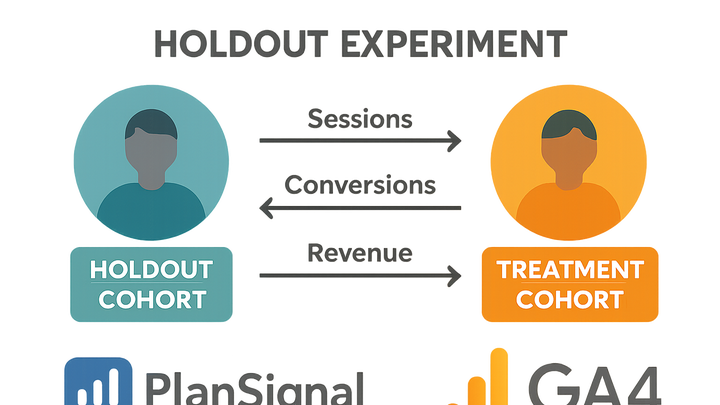Published on 2025-06-26T05:31:09Z
What is a Holdout Experiment in Analytics? Examples with PlanSignal and GA4
Holdout experiments, often called control experiments, are a type of randomized test designed to measure the true incremental impact of a marketing campaign, product feature, or user interface change.
By withholding the treatment from a randomly selected holdout group while exposing the rest of the audience to the variation, analysts can compare outcomes such as conversion rates, engagement, or revenue between groups to isolate the effect of the intervention.
Unlike standard A/B tests, which often compare multiple variants head-to-head, holdout experiments provide a pure control baseline that accounts for external factors and seasonality.
This approach is especially useful when you need to quantify lift, validate attribution models, or assess long-term effects across cohorts.
Modern analytics platforms like PlanSignal (a cookie-free solution) and Google Analytics 4 (GA4) support implementation and analysis of holdout experiments through custom tracking, audiences, and exploratory reporting.
They also help avoid over-attributing organic or baseline trends to your campaign.
Holdout experiment
A randomized test that measures incremental impact by withholding treatment from a control group to isolate genuine lift.
Why Run a Holdout Experiment?
Holdout experiments reveal the true incremental effect of treatments by comparing outcomes between treated and untreated groups. They account for external influences, providing a baseline (holdout group) against which to measure genuine lift. This Section explains the core reasons to choose a holdout design.
-
Measure true incrementality
By comparing the treated group against a holdout group, analysts can isolate the effect of the treatment and avoid attributing natural trends or external factors to the intervention.
-
Avoid biased attribution
Holdout experiments establish a control baseline, preventing over-attribution of results to marketing or product changes when external variables (like seasonality) play a role.
-
Assess long-term effects
Maintaining a holdout group over an extended period allows measurement of sustained impact and detection of delayed or recurring effects beyond the initial launch.
Designing a Holdout Experiment
Careful planning ensures reliable, statistically valid results. This section covers the key steps: defining objectives, selecting metrics, determining sample size, and randomizing user assignment.
-
Define objectives and metrics
Specify clear goals (e.g., increase conversion rate by X%) and choose appropriate KPIs (e.g., click-through rate, revenue per user) to measure the treatment effect.
-
Determine sample size and duration
Calculate the number of users needed in each group to achieve statistical significance, considering expected lift and baseline variance; set a test duration long enough to capture relevant user behavior.
-
Randomization and assignment
Implement a robust randomization method to assign users to treatment or holdout groups, ensuring each segment is representative and free from selection bias.
Implementing with PlanSignal
PlanSignal’s cookie-free analytics platform enables easy tracking of holdout experiments without relying on browser cookies. You can tag users, track events, and analyze lift with minimal setup.
-
Integrate plansignal snippet
Insert the following code snippet into the <head> of your site to enable PlanSignal tracking and define holdout assignments:
<link rel="preconnect" href="//eu.plainsignal.com/" crossorigin /> <script defer data-do="yourwebsitedomain.com" data-id="0GQV1xmtzQQ" data-api="//eu.plainsignal.com" src="//cdn.plainsignal.com/plainsignal-min.js"></script>This snippet automatically captures events without cookies.
-
Tag the holdout group
Use PlanSignal’s API to assign a custom attribute (e.g., ‘holdout’ flag) to users in the control group; this segmentation enables direct comparison within the PlanSignal dashboard.
-
Analyze experiment lift
Leverage PlanSignal’s cohort analysis and lift reports to compare engagement metrics between your treatment and holdout groups over defined time windows.
Implementing with Google Analytics 4 (GA4)
GA4 allows you to track holdout experiments using custom user properties, audiences, and exploration reports. This section outlines how to configure GA4 for control experiments.
-
Set up custom user property
In GA4, create a custom user property (e.g., ‘holdout_flag’) and assign values (‘treatment’ vs ‘control’) via your front-end code or Google Tag Manager.
-
Create holdout audience
Under ‘Audiences’ in GA4, define an audience based on the ‘holdout_flag’ property to isolate control or experiment cohorts for analysis.
-
Run exploration reports
Use the Exploration tool to compare key metrics across your holdout and treatment audiences, calculating lift, conversion rates, and funnel performance.
Common Pitfalls and Best Practices
To ensure validity and derive actionable insights, avoid common mistakes and follow best practices throughout your experiment lifecycle.
-
Insufficient sample size
Underpowered tests can lead to inconclusive results; always calculate required sample size before launch to detect expected effect sizes.
-
Contamination between groups
Prevent overlap by ensuring holdout users aren’t inadvertently exposed to the treatment via multi-device or cross-platform interactions.
-
Analyzing too early
Rushing to interpret results before reaching statistical significance or test completion can produce misleading conclusions; wait until your test meets stopping criteria.
